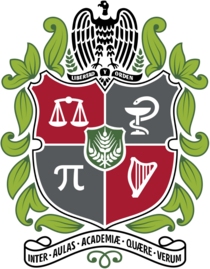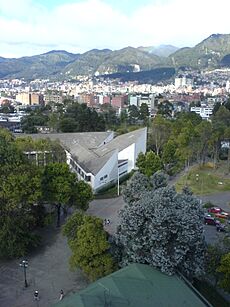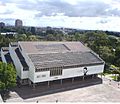National University of Colombia facts for kids
|
Universidad Nacional de Colombia
|
|
 |
|
| Motto | Inter-Aulas-Academiæ-Quære-Verum |
|---|---|
|
Motto in English
|
Search the truth in the rooms of the academy |
| Type | Public, National |
| Established | 22 September 1867 |
| Rector | Leopoldo Múnera Ruiz |
|
Academic staff
|
3,114 (2019) |
|
Administrative staff
|
2,932 (2019) |
| Students | 53,304 (2019) |
| Undergraduates | 44,621 |
| Postgraduates | 8,683 |
| 1,278 | |
| Location |
,
,
4°38′8″N 74°4′58″W / 4.63556°N 74.08278°W |
| Campus | Urban, 300 acres (1,214,056.9 m2) |
| Colours | Green and Red |
 |
|
The National University of Colombia (Spanish: Universidad Nacional de Colombia) is a very important public university in Colombia. It has large campuses in cities like Bogotá, Medellín, Manizales, and Palmira. There are also smaller campuses in places like Leticia and San Andrés.
This university was started in 1867 by the Congress of Colombia. It is one of the biggest universities in the country. More than 53,000 students study here. The university offers many different study programs. These include 95 programs for new students and many more for students who want to study further.
The National University of Colombia is part of important groups like the Association of Colombian Universities. It is also known as one of the "Golden Triangle" universities in Colombia. This means it is one of the best and most competitive universities there.
The university is known for its scientific research. It produces many scientific papers published in important journals. As of June 2025, it was ranked among the top universities in Latin America. It also has a strong online presence in Colombia.
Students at the university can study many different subjects. These include medicine, nursing, dentistry, and engineering. Other subjects are chemistry, pharmacy, mathematics, physics, and biology. You can also study psychology, social sciences, arts (like music), languages, philosophy, and law. In 1967, it was the first university in Colombia to offer a special program in computer science.
Contents
University Campuses
Bogotá Campus: The White City
The main campus is called the University City of Bogotá. People also call it the White City (Spanish: Ciudad Blanca). It is in Bogotá, a bit northwest of the city center. This campus is the largest in Colombia. It has a huge area with many green spaces and walking paths.
Many buildings on this campus are considered national monuments. They show how Colombian architecture has changed over the last 60 years. The campus was designed by Fritz Karsen and Leopold Rother. They started building it in 1935.
The campus is shaped like an oval. From above, it looks like an owl, which stands for wisdom. The buildings are white blocks, giving them a simple and clean look.
Some famous spots on campus include the León de Greiff Auditorium. There is also the Francisco de Paula Santander Plaza, often called the "Central Plaza." The campus even has its own stadium, Alfonso López Pumarejo Stadium. Sometimes, professional football games are played there.
Medellín Campus: Engineering Focus
The Medellín campus has two main areas: the Central Campus and Robledo Campus. About 10,447 students study here. This campus offers many spots for new students each year. It also has many professors, with a high number holding advanced degrees.
The Medellín campus offers 26 programs for new students. It also has 73 programs for advanced studies, including PhDs and Master's degrees. This campus is especially known for its engineering programs. It has 17 engineering programs, which is the most among all National University of Colombia campuses.
The Central Campus in Medellín is located near El Volador hill. It has been part of the university since 1938. This campus has a large area with several learning centers. These include the Entomological Museum and the Central Library "Efe Gomez."
The Robledo Campus is also known as the School of Mines. It was created in 1886 and joined the university in 1936. About 3,500 students study here. This campus has the Museum of Geosciences. Some of its buildings are also national monuments because of their architecture and murals.
Academics and Studies
| University rankings | |
|---|---|
| Global – Overall | |
| ARWU World | 901–1000 (2023) |
| QS World | =259 (2026) |
| THE World | 1201–1500 (2024) |
| USNWR Global | =662 (2023) |
The National University of Colombia has 20 main schools. These are spread across its campuses in Bogotá, Medellín, Manizales, and Palmira.
Here are some of the schools in Bogotá:
- Agricultural Sciences
- Dentistry
- Economics sciences
- Engineering
- Fine Arts
- Human Sciences
- Law, Social and Political Sciences
- Medicine
- Nursing Faculty
- Science
- Veterinary Medicine and Animal Management
The university also has special institutes that focus on specific research areas. These include the Institute of Biotechnology and the Institute of Environmental Studies.
There are several museums on the Bogotá Campus:
- Casa Museo Jorge Eliécer Gaitán (Jorge Eliecer Gaitan Museum)
- Museo de Arte Universidad Nacional de Colombia (National University's Art Museum)
- Museo de Arquitectura Leopoldo Rother (Leopoldo Rother Museum of Architecture)
- Museo de Historia Natural (Museum of Natural History)
- Museo de la Ciencia y el Juego (Museum of Science and Games)
- Museo Centro de Historia de la Medicina (Museum Centre of the History of Medicine)
- Museo Entomológico (Entomological Museum)
- Observatorio Astronómico Nacional (National Astronomical Observatory)
The university even has a high school for children of its staff and students.
In Medellín, the schools include:
- Sciences
- Agricultural Sciences
- Mines
- Economics and Humans Sciences
- Architecture
The Medellín campus also has its own museums, like the Earth Sciences Museum and the Entomological Museum. It has research centers focused on areas like energy and materials.
The university also has its own media channels. These include a news agency, a radio station (UN Radio), and a TV production company. They help share news and academic information.
Noted People
University Leaders (Chancellors)
Many people have led the National University of Colombia over the years. The current rector (leader) is Leopoldo Múnera Ruiz. Some past leaders include:
- Jaime Jaramillo Arango
- Antanas Mockus Sivickas
- Dolly Montoya Castaño
Famous Alumni
Many famous people have studied at the National University of Colombia. Some of them are:
- Fernando Botero (a famous artist)
- Gabriel García Márquez (a Nobel Prize-winning writer)
- Sofía Vergara (a well-known actress)
- Antanas Mockus (a former mayor of Bogotá)
- Jaime Garzón (a popular comedian and journalist)
- Manuel Elkin Patarroyo (a scientist known for malaria research)
- Luis Carlos Sarmiento Angulo (a successful businessman)
Notable Faculty
- Claudia Patricia Vaca Gonzalez - A chemist and professor who studies how medicines affect people.
Images for kids
See also
 In Spanish: Universidad Nacional de Colombia para niños
In Spanish: Universidad Nacional de Colombia para niños
- List of universities in Colombia




















